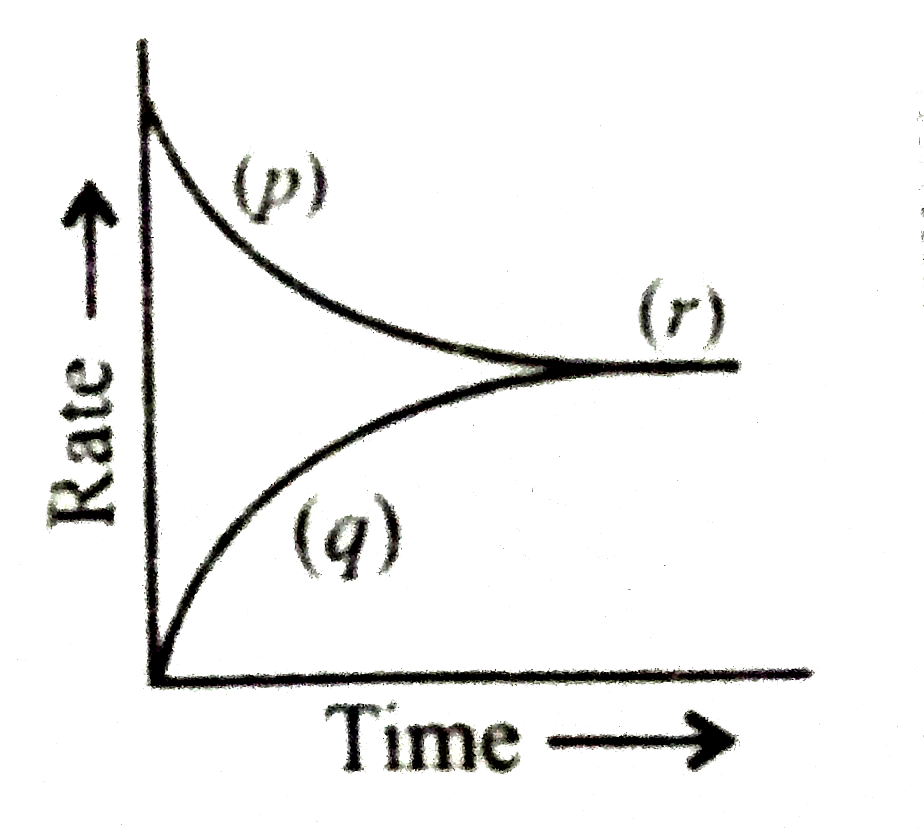For reversible reaction, A+B⇔C+D, the graph for rate of reaction with time is given below.
Mark the terms (p),(q) and (r )

(p)-rate of backward reaction ,(q)-rate of forward reaction, (r )-equilibrium,
(p)-rate of forward reaction, (q)-rate of backward reaction, (r )-equilibrium
(p)-concentration of products (q)-concentration of reactants (r )-rate of reaction
(p)-instantaneous rate of reaction, (q)-variation of rate, (r )-average rate of reaction
The correct Answer is:B
Rate of forward reaction decreases and rate of backward reaction increases with passage of time. At equilibrium both the rates become equal.
Topper's Solved these Questions
- CHEMICAL KINETICSBOOK - NCERT FINGERTPS ENGLISHCHAPTER - CHEMICAL KINETICSEXERCISE - Factors Influencing Rate Of Reaction
30 Videos
- CHEMICAL KINETICSBOOK - NCERT FINGERTPS ENGLISHCHAPTER - CHEMICAL KINETICSEXERCISE - Integrated Rate Equation
25 Videos
- CHEMICAL KINETICSBOOK - NCERT FINGERTPS ENGLISHCHAPTER - CHEMICAL KINETICSEXERCISE - ASSERTION & REASON
15 Videos
- BIOMOLECULESBOOK - NCERT FINGERTPS ENGLISHCHAPTER - BIOMOLECULESEXERCISE - Assertion And Reason
15 Videos
- CHEMISTRY IN EVERYDAY LIFE BOOK - NCERT FINGERTPS ENGLISHCHAPTER - CHEMISTRY IN EVERYDAY LIFE EXERCISE - NCERT Exemplar
15 Videos
Similar Questions
Knowledge Check
The reaction in terms of intermediates and type of reaction is given below. Mark the incorrect option.
ACH3−CH3∣C=CH2+HBr→ Carbocation intermediateBCH3−CH3∣C=CH2+HBrperoxide−−−−→Free radical intermediateC D
D
The rate law for reaction A+2B⇔C+2D will be :
View SolutionFor the reaction A+3B→C+D rate of reactions ∝[A][B]
View SolutionIn the reversible reaction of the type A+B⇔AB, in general.
View SolutionIn the reversible reaction A + B ⇔ C + D, the concentration of each C and D at equilobrium was 0.8 mole/litre, then the equilibrium constant Kc will be
View SolutionGive the products of the reactions given below.
b.
c.
d.
e.
View SolutionFor the reaction A+B→C+D, the initial rate for different reactions and initial concentration of reactants are given below:

(i) What is the overall order of reaction ?
(ii) Write the rate law equation.
View SolutionFor a reaction A+2B→C, rate is given by R=K[A][B]2. The order of reaction is:
View Solution
